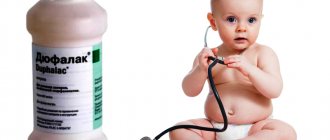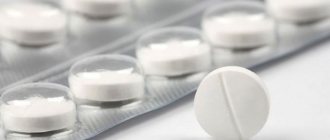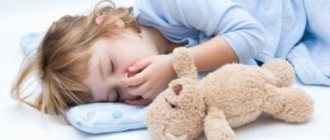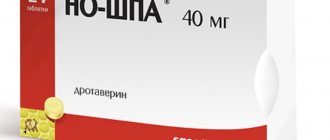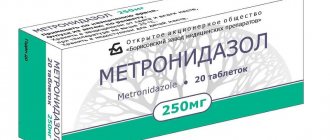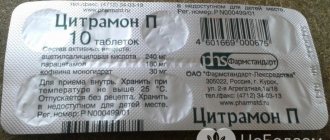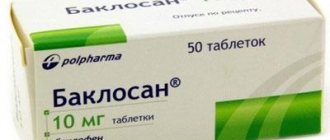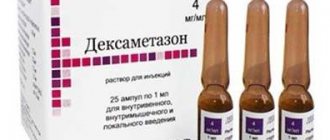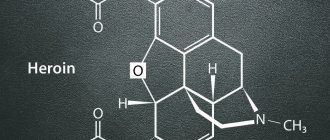INSTRUCTIONS (information for specialists) on the medical use of the drug
Registration number:
Trade patent name: ATARAX ® (ATARAX ®)
International nonproprietary name : hydroxyzine
Chemical name: ethanol, 2[-2-[-4-[(4-chlorophenyl)phenylmethyl]-1-piperazine]ethoxy]-, dihydrochloride.
Dosage forms: Solution for intramuscular administration; film-coated tablets.
Compound
Tablets: active substance - hydroxyzine hydrochloride 25 mg; excipients: microcrystalline cellulose (Avicel RN 102 ®), magnesium stearate, silicon colloidal anhydride (Aerosil 200 ®), lactose monohydrate, Opadry ® Y-1-7000: titanium dioxide, hydroxypropyl methylcellulose 2910 5cP, macrogol 400.
Solution for intramuscular administration: active substance - hydroxyzine hydrochloride 100 mg in 2 ml; inactive components: sodium hydroxide, water for injection.
Description
White oblong film-coated tablets with a dividing line on both sides.
The solution for intramuscular administration is a clear, colorless solution.
Pharmacotherapeutic group:
ATX code: No. 05BB01.
PHARMACOLOGICAL PROPERTIES
A derivative of diphenylmethane, it has moderate anxiolytic activity; It also has a sedative, antiemetic, antihistamine and M-anticholinergic effect. Blocks central M-cholino and H1-histamine receptors and inhibits the activity of certain subcortical zones. Does not cause mental dependence or addiction. The clinical effect occurs 15-30 minutes after ingestion of the tablets. Has a positive effect on cognitive abilities, improves memory and attention. Relaxes skeletal and smooth muscles, has bronchodilator and analgesic effects, and a moderate inhibitory effect on gastric secretion. Hydroxyzine significantly reduces itching in patients with urticaria, eczema and dermatitis. With long-term use, there was no withdrawal syndrome or deterioration of cognitive functions. Polysomnography in patients with insomnia and anxiety clearly demonstrates an increase in sleep duration and a decrease in the frequency of night awakenings after taking hydroxyzine once or repeatedly at a dose of 50 mg. A decrease in muscle tension in patients with anxiety was noted when taking the drug at a dose of 50 mg 3 times a day.
Pharmacokinetics. Absorption is high. Time to reach maximum concentration (TCmax) after oral administration is 2 hours; half-life (T1/2) in adults is 14 hours. Metabolites are found in breast milk. After taking a single dose of 25 mg, the TCmax in adults is 30 mg/ml and 70 mg/ml after taking 50 mg hydroxyzine. Bioavailability when taken orally and intramuscularly is 80%.
Hydroxyzine is more concentrated in the skin than in plasma. The distribution coefficient is 7-16 l/kg in adults. Hydroxyzine penetrates the blood-brain barrier and the placenta, concentrating more in fetal than maternal tissues. Hydroxyzine is metabolized in the liver. Cetirizine, the main metabolite (45%), is a pronounced H1 blocker. The total clearance of hydroxyzine is 13 ml/min/kg. Only 0.8% of hydroxyzine is excreted unchanged through the kidneys.
In children, the total clearance is 4 times shorter than in adults, T1/2 is 11 hours in children aged 14 years and 4 hours at the age of 1 year. In elderly patients, T1/2 was 29 hours, the distribution coefficient was 22.5 l/kg. In patients with liver diseases, T1/2 increased to 37 hours, the concentration of metabolites in the blood serum was higher than in young patients with normal liver function. The antihistamine effect can last up to 96 hours after administration.
of stresam was carried out at the Scientific Center for Mental Health at the Russian Academy of Sciences
and
atarax
in the treatment of anxiety disorders. Today, the treatment of anxiety disorders caused by adjustment disorders or as a generalized anxiety disorder is an important task for psychiatrists.
The study involved three dozen people aged from eighteen to seventy-five years old suffering from anxiety syndromes. Fifteen patients were prescribed the drug strezam
, and fifteen
atarax
. Atarax was prescribed at 75 milligrams per day to begin with, but later it could be increased depending on feasibility.
The results of treatment were monitored every two weeks using special scales. Thus, at the end of treatment, mood anxiety dropped by twenty-five points, tension by twenty-two points, fears decreased from eighteen to eleven points, and intellectual impairment decreased from fourteen to eleven points. Behavior during examination was normalized, the manifestation of muscle somatic symptoms significantly decreased - from thirty-two to fifteen points. The severity of vegetative symptoms decreased significantly - from twenty-eight to sixteen points.
Atarax: about the drug
Atarax is a medicine with a sedative effect, part of the group of tranquilizers.
The active substance is hydroxyzine hydrochloride. When taken, it has a calming, antiemetic effect. The medicine blocks histamine receptors, so it can be used for itchy skin. In what other cases is Atarax prescribed?
Indications for use:
- panic attacks;
- increased anxiety;
- constant internal tension;
- intense excitement;
- withdrawal syndrome after prolonged use of alcohol;
- itching of the skin;
- preparation for surgical interventions;
- adaptation disorder.
Available in tablets and solution for intramuscular administration. Atarax has a serious effect on the human body. The prescribed dosage must be carefully observed.
Atarax contraindications:
- intolerance to the components of the product;
- porphyria;
- pregnancy and lactation;
- allergic reactions to galactose;
- children under three years of age;
- kidney and liver failure;
- prostate diseases;
- epileptic seizures;
- some eye diseases;
- frequent constipation;
- disturbances in heart rhythm.
Atarax is not allowed to be taken simultaneously with certain sedatives and sleeping pills. If you need to take several medications at once, you need to consult a specialist. When the drug is taken correctly, addiction does not occur, and there is no withdrawal syndrome after the end of therapy.
You will like the article: “ Lethally life-threatening drugs and pills - list .”
The action of Atarax begins half an hour after administration. There is a decrease in blood pressure, normalization of heart rate, improved sleep, and muscle tissue relaxes. If used incorrectly, side effects develop in the form of weakness, dizziness, constipation, and disruptions in the functioning of the cardiac system.
An overdose of the drug Atarax has a code according to ICD 10 - T36-T50 - drug poisoning.
Pharmacological group
| Category ICD-10 | Synonyms of diseases according to ICD-10 |
| F10.2 Alcohol dependence syndrome | Alcoholism |
| Alcohol addiction | |
| Dipsomania | |
| Alcohol addiction | |
| Binge drinking | |
| Drunken state | |
| Alcohol abuse | |
| Ideation disorder in alcoholism | |
| Quarterly binge | |
| Obsessive craving for alcohol | |
| Neurotic symptoms in alcoholism | |
| Pathological craving for alcohol | |
| Psychoorganic syndrome in chronic alcoholism | |
| Reduced craving for alcohol | |
| Chronic alcoholism | |
| F10.3 Withdrawal state | Alcohol withdrawal syndrome |
| Withdrawal syndrome | |
| Withdrawal syndrome in alcoholism | |
| Abstinence | |
| Alcohol withdrawal | |
| Alcohol withdrawal | |
| Alcohol withdrawal state | |
| Alcohol withdrawal syndrome | |
| Post-withdrawal disorder | |
| Post-withdrawal state | |
| Hangover syndrome | |
| Withdrawal syndrome | |
| Alcohol withdrawal syndrome | |
| Alcohol withdrawal syndrome | |
| Withdrawal state | |
| F10.4 Withdrawal state with delirium | Alcohol delirium |
| Alcoholic delirium tremens | |
| Delirium | |
| Delirious state in alcoholism and drug addiction | |
| F41 Other anxiety disorders | Relief of anxiety |
| Non-psychotic anxiety disorders | |
| Alarm state | |
| Anxiety | |
| Anxious and suspicious states | |
| Chronic anxiety | |
| Sense of anxiety | |
| F48 Other neurotic disorders | Neurosis |
| Neurological diseases | |
| Neurotic disorders | |
| Neurotic state | |
| Psychoneurosis | |
| Anxiety-neurotic conditions | |
| Chronic neurotic disorders | |
| Emotional reactive disorders | |
| L29 Itching | Itchy dermatitis |
| Dermatosis with persistent itching | |
| Other pruritic dermatoses | |
| Itching of the scalp | |
| Itchy skin | |
| Itching with partial obstruction of the bile ducts | |
| Itchy eczema | |
| Pruritic dermatoses | |
| Pruritic allergic dermatosis | |
| Pruritic dermatitis | |
| Pruritic dermatosis | |
| Itchy skin | |
| Skin itching due to dermatosis | |
| Excruciating itching | |
| Limited pruritic dermatitis | |
| Severe itching | |
| Endogenous skin itching | |
| R45.1 Restlessness and agitation | Agitation |
| Anxiety | |
| Explosive excitability | |
| Internal excitement | |
| Excitability | |
| Excitation | |
| Excitement is acute | |
| Psychomotor agitation | |
| Hyperexcitability | |
| Motor excitement | |
| Relief of psychomotor agitation | |
| Nervous excitement | |
| Restlessness | |
| Night restlessness | |
| Acute stage of schizophrenia with agitation | |
| Acute mental agitation | |
| Paroxysm of excitement | |
| Overexcitement | |
| Increased excitability | |
| Increased nervous excitability | |
| Increased emotional and cardiac excitability | |
| Increased arousal | |
| Mental excitement | |
| Psychomotor agitation | |
| Psychomotor agitation | |
| Psychomotor agitation | |
| Psychomotor agitation in psychosis | |
| Psychomotor agitation of an epileptic nature | |
| Psychomotor paroxysm | |
| Psychomotor seizure | |
| Symptoms of arousal | |
| Symptoms of psychomotor agitation | |
| State of agitation | |
| State of anxiety | |
| State of excitement | |
| A state of heightened anxiety | |
| State of psychomotor agitation | |
| States of anxiety | |
| States of arousal | |
| State of agitation in somatic diseases | |
| State of excitement | |
| Feeling restless | |
| Emotional excitement | |
| R45.4 Irritability and anger | Outbursts of anger |
| Anger | |
| Dysphoria | |
| Neurosis with increased irritability | |
| Bitterness | |
| Increased irritability | |
| Increased irritability of the nervous system | |
| Irritability | |
| Irritability with neuroses | |
| Irritability in psychopathic disorders | |
| Symptoms of irritability | |
| Z100* CLASS XXII Surgical practice | Abdominal surgery |
| Adenomectomy | |
| Amputation | |
| Angioplasty of coronary arteries | |
| Carotid angioplasty | |
| Antiseptic treatment of skin for wounds | |
| Antiseptic hand treatment | |
| Appendectomy | |
| Atherectomy | |
| Balloon coronary angioplasty | |
| Vaginal hysterectomy | |
| Corona bypass | |
| Interventions on the vagina and cervix | |
| Bladder interventions | |
| Intervention in the oral cavity | |
| Restorative and reconstructive operations | |
| Hand hygiene of medical personnel | |
| Gynecological surgery | |
| Gynecological interventions | |
| Gynecological surgeries | |
| Hypovolemic shock during surgery | |
| Disinfection of purulent wounds | |
| Disinfection of wound edges | |
| Diagnostic interventions | |
| Diagnostic procedures | |
| Diathermocoagulation of the cervix | |
| Long surgical operations | |
| Replacing fistula catheters | |
| Infection during orthopedic surgery | |
| Artificial heart valve | |
| Cystectomy | |
| Short-term outpatient surgery | |
| Short-term operations | |
| Short-term surgical procedures | |
| Cricothyroidotomy | |
| Blood loss during surgery | |
| Bleeding during surgery and in the postoperative period | |
| Culdocentesis | |
| Laser coagulation | |
| Laser coagulation | |
| Laser coagulation of the retina | |
| Laparoscopy | |
| Laparoscopy in gynecology | |
| CSF fistula | |
| Minor gynecological operations | |
| Minor surgical interventions | |
| Mastectomy and subsequent plastic surgery | |
| Mediastinotomy | |
| Microsurgical operations on the ear | |
| Mucogingival surgeries | |
| Stitching | |
| Minor surgeries | |
| Neurosurgical operation | |
| Immobilization of the eyeball in ophthalmic surgery | |
| Orchiectomy | |
| Complications after tooth extraction | |
| Pancreatectomy | |
| Pericardectomy | |
| Rehabilitation period after surgery | |
| The period of convalescence after surgical interventions | |
| Percutaneous transluminal coronary angioplasty | |
| Pleural thoracentesis | |
| Pneumonia postoperative and post-traumatic | |
| Preparing for surgical procedures | |
| Preparing for surgery | |
| Preparing the surgeon's hands before surgery | |
| Preparing the colon for surgery | |
| Postoperative aspiration pneumonia during neurosurgical and thoracic operations | |
| Postoperative nausea | |
| Postoperative bleeding | |
| Postoperative granuloma | |
| Postoperative shock | |
| Early postoperative period | |
| Myocardial revascularization | |
| Resection of the apex of the tooth root | |
| Gastric resection | |
| Bowel resection | |
| Resection of the uterus | |
| Liver resection | |
| Small bowel resection | |
| Resection of part of the stomach | |
| Reocclusion of the operated vessel | |
| Bonding tissue during surgery | |
| Removing stitches | |
| Condition after eye surgery | |
| Condition after surgery | |
| Condition after surgical interventions in the nasal cavity | |
| Condition after gastrectomy | |
| Condition after resection of the small intestine | |
| Condition after tonsillectomy | |
| Condition after removal of the duodenum | |
| Condition after phlebectomy | |
| Vascular surgery | |
| Splenectomy | |
| Sterilization of surgical instruments | |
| Sterilization of surgical instruments | |
| Sternotomy | |
| Dental operations | |
| Dental intervention on periodontal tissues | |
| Strumectomy | |
| Tonsillectomy | |
| Thoracic surgery | |
| Thoracic operations | |
| Total gastrectomy | |
| Transdermal intravascular coronary angioplasty | |
| Transurethral resection | |
| Turbinectomy | |
| Removal of a tooth | |
| Cataract removal | |
| Cyst removal | |
| Tonsil removal | |
| Removal of fibroids | |
| Removal of mobile baby teeth | |
| Removal of polyps | |
| Removing a broken tooth | |
| Removal of the uterine body | |
| Removing stitches | |
| Urethrotomy | |
| CSF duct fistula | |
| Frontoethmoidohaymorotomy | |
| Surgical infection | |
| Surgical treatment of chronic limb ulcers | |
| Surgery | |
| Surgery in the anal area | |
| Colon surgery | |
| Surgical practice | |
| Surgical procedure | |
| Surgical interventions | |
| Surgical interventions on the gastrointestinal tract | |
| Surgical interventions on the urinary tract | |
| Surgical interventions on the urinary system | |
| Surgical interventions on the genitourinary system | |
| Heart surgery | |
| Surgical procedures | |
| Surgical operations | |
| Vein surgery | |
| Surgical intervention | |
| Vascular surgery | |
| Surgical treatment of thrombosis | |
| Surgery | |
| Cholecystectomy | |
| Partial gastrectomy | |
| Transperitoneal hysterectomy | |
| Percutaneous transluminal coronary angioplasty | |
| Percutaneous transluminal angioplasty | |
| Coronary artery bypass surgery | |
| Tooth extirpation | |
| Extirpation of baby teeth | |
| Pulp extirpation | |
| Extracorporeal circulation | |
| Tooth extraction | |
| Tooth extraction | |
| Cataract extraction | |
| Electrocoagulation | |
| Endourological interventions | |
| Episiotomy | |
| Ethmoidotomy |
How can you get poisoned by Atarax?
Why does Atarax intoxication occur? There are several reasons that provoke the development of an overdose:
- Taking medication without a doctor's prescription.
- Independently increase the amount of the drug, especially in stressful situations.
- Simultaneous use of Atarax with alcoholic beverages.
- Taken together with other sedative medications.
In children, poisoning often occurs due to the fault of parents who leave the drug in accessible places.
How many tablets of Atarax overdose will lead to death? The maximum permissible daily dose for adults is 300 mg; no more than 200 mg is allowed to be taken at a time. For children, the permissible amount is determined depending on weight and age:
- children under 6 years old – 1-2.5 mg per kg of body weight per day in several doses;
- children over 6 years old - 2-3 mg per kg of body weight several times a day.
The dosage for older people at the initial stage is reduced by half . The drug is taken with food. If a pill was missed, then taking a double dosage is prohibited.
Medicinal properties
The drug Atarax is an anxiolytic of moderate intensity. At the same time, it calms the nervous system, eliminates and prevents vomiting, relieves allergic symptoms, and blocks the activity of m-cholinergic receptors.
The therapeutic effect is achieved thanks to the properties of the active component of Atarax - hydroxyzine, presented in the form of hydrochloride. The substance disables the activity of central muscarinic-sensitive cholinergic receptors, histamine H1 receptors, as a result of which the functioning of the subcortical areas controlled by them is suppressed. The medicine is not addictive or dependent. The therapeutic effect appears 20-30 minutes after administration.
The medication has a positive effect on mental skills, enhances attention, and strengthens memory. It has a relaxing effect on smooth and skeletal muscles, has a bronchodilator and analgesic effect, and has a moderate inhibitory effect on secretion in the gastrointestinal tract.
At the same time, the substance relieves itching in patients suffering from skin lesions - urticaria, dermatitis, eczema. With a long course it does not depress mental activity. The treatment has a positive effect on sleep patterns: it normalizes periods of wakefulness and rest, eliminates insomnia, reduces the frequency of awakenings or prevents them completely.
After oral administration, it is almost completely absorbed from the gastrointestinal tract. Maximum concentrations in the body are achieved 2 hours after application.
It is distributed mainly throughout the tissues, especially high content is observed in the layers of the skin.
Hydroxyzine is highly active: it is able to overcome the BBB and penetrate the placental barrier. Moreover, in the latter case, its concentration in the fetal tissues significantly exceeds the content in the mother’s body. Excreted into milk.
Metabolic processes occur in the liver, its main metabolite exhibits the properties of a histamine H1 receptor blocker. Half-life from the body takes about 14 hours. In elderly patients and patients with liver pathologies, the process takes a longer period of time - up to 36-37 hours. The therapeutic effect of Atarax lasts for up to 95-96 hours.
Symptoms of drug overdose
How does an overdose of Atarax manifest itself?
The first signs are diagnosed an hour after consuming an increased amount of medication. The degree of manifestation depends on the severity of poisoning, weight and age of the patient. Acute poisoning is characterized by the following symptoms:
- nausea;
- intense vomiting;
- disturbances in heart rhythm;
- excitement turning into apathy;
- a sharp decrease in pressure;
- slow breathing;
- hallucinations;
- disturbance of consciousness;
- convulsions;
- lack of orientation in space;
- coma.
In patients with low body weight and children, poisoning develops quickly. In older people, an overdose can occur even with a slight increase in the prescribed amount.
Synonyms of nosological groups
| Category ICD-10 | Synonyms of diseases according to ICD-10 |
| F10.2 Alcohol dependence syndrome | Alcoholism |
| Alcohol addiction | |
| Dipsomania | |
| Alcohol addiction | |
| Binge drinking | |
| Drunken state | |
| Alcohol abuse | |
| Ideation disorder in alcoholism | |
| Quarterly binge | |
| Obsessive craving for alcohol | |
| Neurotic symptoms in alcoholism | |
| Pathological craving for alcohol | |
| Psychoorganic syndrome in chronic alcoholism | |
| Reduced craving for alcohol | |
| Chronic alcoholism | |
| F10.3 Withdrawal state | Alcohol withdrawal syndrome |
| Withdrawal syndrome | |
| Withdrawal syndrome in alcoholism | |
| Abstinence | |
| Alcohol withdrawal | |
| Alcohol withdrawal | |
| Alcohol withdrawal state | |
| Alcohol withdrawal syndrome | |
| Post-withdrawal disorder | |
| Post-withdrawal state | |
| Hangover syndrome | |
| Withdrawal syndrome | |
| Alcohol withdrawal syndrome | |
| Alcohol withdrawal syndrome | |
| Withdrawal state | |
| F10.4 Withdrawal state with delirium | Alcohol delirium |
| Alcoholic delirium tremens | |
| Delirium | |
| Delirious state in alcoholism and drug addiction | |
| F41 Other anxiety disorders | Relief of anxiety |
| Non-psychotic anxiety disorders | |
| Alarm state | |
| Anxiety | |
| Anxious and suspicious states | |
| Chronic anxiety | |
| Sense of anxiety | |
| F48 Other neurotic disorders | Neurosis |
| Neurological diseases | |
| Neurotic disorders | |
| Neurotic state | |
| Psychoneurosis | |
| Anxiety-neurotic conditions | |
| Chronic neurotic disorders | |
| Emotional reactive disorders | |
| L29 Itching | Itchy dermatitis |
| Dermatosis with persistent itching | |
| Other pruritic dermatoses | |
| Itching of the scalp | |
| Itchy skin | |
| Itching with partial obstruction of the bile ducts | |
| Itchy eczema | |
| Pruritic dermatoses | |
| Pruritic allergic dermatosis | |
| Pruritic dermatitis | |
| Pruritic dermatosis | |
| Itchy skin | |
| Skin itching due to dermatosis | |
| Excruciating itching | |
| Limited pruritic dermatitis | |
| Severe itching | |
| Endogenous skin itching | |
| R45.1 Restlessness and agitation | Agitation |
| Anxiety | |
| Explosive excitability | |
| Internal excitement | |
| Excitability | |
| Excitation | |
| Excitement is acute | |
| Psychomotor agitation | |
| Hyperexcitability | |
| Motor excitement | |
| Relief of psychomotor agitation | |
| Nervous excitement | |
| Restlessness | |
| Night restlessness | |
| Acute stage of schizophrenia with agitation | |
| Acute mental agitation | |
| Paroxysm of excitement | |
| Overexcitement | |
| Increased excitability | |
| Increased nervous excitability | |
| Increased emotional and cardiac excitability | |
| Increased arousal | |
| Mental excitement | |
| Psychomotor agitation | |
| Psychomotor agitation | |
| Psychomotor agitation | |
| Psychomotor agitation in psychosis | |
| Psychomotor agitation of an epileptic nature | |
| Psychomotor paroxysm | |
| Psychomotor seizure | |
| Symptoms of arousal | |
| Symptoms of psychomotor agitation | |
| State of agitation | |
| State of anxiety | |
| State of excitement | |
| A state of heightened anxiety | |
| State of psychomotor agitation | |
| States of anxiety | |
| States of arousal | |
| State of agitation in somatic diseases | |
| State of excitement | |
| Feeling restless | |
| Emotional excitement | |
| R45.4 Irritability and anger | Outbursts of anger |
| Anger | |
| Dysphoria | |
| Neurosis with increased irritability | |
| Bitterness | |
| Increased irritability | |
| Increased irritability of the nervous system | |
| Irritability | |
| Irritability with neuroses | |
| Irritability in psychopathic disorders | |
| Symptoms of irritability | |
| Z100* CLASS XXII Surgical practice | Abdominal surgery |
| Adenomectomy | |
| Amputation | |
| Angioplasty of coronary arteries | |
| Carotid angioplasty | |
| Antiseptic treatment of skin for wounds | |
| Antiseptic hand treatment | |
| Appendectomy | |
| Atherectomy | |
| Balloon coronary angioplasty | |
| Vaginal hysterectomy | |
| Corona bypass | |
| Interventions on the vagina and cervix | |
| Bladder interventions | |
| Intervention in the oral cavity | |
| Restorative and reconstructive operations | |
| Hand hygiene of medical personnel | |
| Gynecological surgery | |
| Gynecological interventions | |
| Gynecological surgeries | |
| Hypovolemic shock during surgery | |
| Disinfection of purulent wounds | |
| Disinfection of wound edges | |
| Diagnostic interventions | |
| Diagnostic procedures | |
| Diathermocoagulation of the cervix | |
| Long surgical operations | |
| Replacing fistula catheters | |
| Infection during orthopedic surgery | |
| Artificial heart valve | |
| Cystectomy | |
| Short-term outpatient surgery | |
| Short-term operations | |
| Short-term surgical procedures | |
| Cricothyroidotomy | |
| Blood loss during surgery | |
| Bleeding during surgery and in the postoperative period | |
| Culdocentesis | |
| Laser coagulation | |
| Laser coagulation | |
| Laser coagulation of the retina | |
| Laparoscopy | |
| Laparoscopy in gynecology | |
| CSF fistula | |
| Minor gynecological operations | |
| Minor surgical interventions | |
| Mastectomy and subsequent plastic surgery | |
| Mediastinotomy | |
| Microsurgical operations on the ear | |
| Mucogingival surgeries | |
| Stitching | |
| Minor surgeries | |
| Neurosurgical operation | |
| Immobilization of the eyeball in ophthalmic surgery | |
| Orchiectomy | |
| Complications after tooth extraction | |
| Pancreatectomy | |
| Pericardectomy | |
| Rehabilitation period after surgery | |
| The period of convalescence after surgical interventions | |
| Percutaneous transluminal coronary angioplasty | |
| Pleural thoracentesis | |
| Pneumonia postoperative and post-traumatic | |
| Preparing for surgical procedures | |
| Preparing for surgery | |
| Preparing the surgeon's hands before surgery | |
| Preparing the colon for surgery | |
| Postoperative aspiration pneumonia during neurosurgical and thoracic operations | |
| Postoperative nausea | |
| Postoperative bleeding | |
| Postoperative granuloma | |
| Postoperative shock | |
| Early postoperative period | |
| Myocardial revascularization | |
| Resection of the apex of the tooth root | |
| Gastric resection | |
| Bowel resection | |
| Resection of the uterus | |
| Liver resection | |
| Small bowel resection | |
| Resection of part of the stomach | |
| Reocclusion of the operated vessel | |
| Bonding tissue during surgery | |
| Removing stitches | |
| Condition after eye surgery | |
| Condition after surgery | |
| Condition after surgical interventions in the nasal cavity | |
| Condition after gastrectomy | |
| Condition after resection of the small intestine | |
| Condition after tonsillectomy | |
| Condition after removal of the duodenum | |
| Condition after phlebectomy | |
| Vascular surgery | |
| Splenectomy | |
| Sterilization of surgical instruments | |
| Sterilization of surgical instruments | |
| Sternotomy | |
| Dental operations | |
| Dental intervention on periodontal tissues | |
| Strumectomy | |
| Tonsillectomy | |
| Thoracic surgery | |
| Thoracic operations | |
| Total gastrectomy | |
| Transdermal intravascular coronary angioplasty | |
| Transurethral resection | |
| Turbinectomy | |
| Removal of a tooth | |
| Cataract removal | |
| Cyst removal | |
| Tonsil removal | |
| Removal of fibroids | |
| Removal of mobile baby teeth | |
| Removal of polyps | |
| Removing a broken tooth | |
| Removal of the uterine body | |
| Removing stitches | |
| Urethrotomy | |
| CSF duct fistula | |
| Frontoethmoidohaymorotomy | |
| Surgical infection | |
| Surgical treatment of chronic limb ulcers | |
| Surgery | |
| Surgery in the anal area | |
| Colon surgery | |
| Surgical practice | |
| Surgical procedure | |
| Surgical interventions | |
| Surgical interventions on the gastrointestinal tract | |
| Surgical interventions on the urinary tract | |
| Surgical interventions on the urinary system | |
| Surgical interventions on the genitourinary system | |
| Heart surgery | |
| Surgical procedures | |
| Surgical operations | |
| Vein surgery | |
| Surgical intervention | |
| Vascular surgery | |
| Surgical treatment of thrombosis | |
| Surgery | |
| Cholecystectomy | |
| Partial gastrectomy | |
| Transperitoneal hysterectomy | |
| Percutaneous transluminal coronary angioplasty | |
| Percutaneous transluminal angioplasty | |
| Coronary artery bypass surgery | |
| Tooth extirpation | |
| Extirpation of baby teeth | |
| Pulp extirpation | |
| Extracorporeal circulation | |
| Tooth extraction | |
| Tooth extraction | |
| Cataract extraction | |
| Electrocoagulation | |
| Endourological interventions | |
| Episiotomy | |
| Ethmoidotomy |
First aid and methods of treating intoxication
If signs of poisoning are diagnosed, then you need to immediately call a team of doctors. The patient is given first aid to cleanse the body of the toxin. The following actions are carried out at home:
- Gastric lavage. The victim is given a large volume of water to drink and vomiting is induced.
- Reception of sorbents. Similar drugs include activated carbon, Enterosgel, Polysorb, Polyphepan.
- Drinking fluids. The patient is given to drink more water and sweet tea to avoid the development of dehydration.
If the victim is unconscious, then he is laid down, his head is turned to the side to avoid choking on vomit. Before doctors arrive, the patient’s condition is monitored. If necessary, perform resuscitation actions.
Analogs
Only a doctor can select analogues and substitutes for Atarax.
Phenibut
Mir-Pharm, Ozon, Moscow EZ, Pharmtechnologies (RF)
Price: (10 tablets) – 63 rubles, (20 tablets) – 86 rubles.
Drugs based on γ-amino-β-phenylbutyric acid hydrochloride. used for the treatment of anxiety-neurotic disorders (fear, anxiety), sleep disorders in elderly patients, elimination of anxiety before surgery. Also used to treat vertigo and Meniere's disease. In pediatrics, it is indicated for the treatment of stuttering and nervous tics. It can be used as an additional remedy in the treatment of alcohol withdrawal.
Only a doctor who knows the characteristics of the patient should choose between two drugs, which will help better - Phenibut or Atarax.
Pros:
- Available remedy
- Helps with stuttering
- Eliminates insomnia.
Minuses:
- Headache.
Preventive measures
What does a drug overdose lead to? Intoxication with Atarax in severe form provokes the development of various negative consequences. The functioning of the kidneys and liver is disrupted, the nervous system suffers, and chronic diseases worsen.
In the absence of help and proper treatment, death is possible. It is possible to avoid an overdose by following the preventive rules:
- do not use Atarax on your own;
- store the drug in inaccessible places;
- strictly follow the instructions.
An overdose of Atarax occurs as a result of exceeding the specified dosage. If signs of intoxication are detected, you must seek help from a medical facility.
Anna:
There were often problems with the intestines, any food led to poisoning. I tried a lot of things, but there was no result.
I decided to try the teas. The monastery collection of Father George began to help me well.
Further treatment is carried out in a medical institution in the toxicology department. Therapy includes various procedures and medications:
- Gastric lavage through a tube.
- Colon cleansing if necessary.
- Administration of norepinephrine and medicinal solutions.
- Prescription of drugs that restore the functioning of the cardiac, digestive, nervous systems and other internal organs.
There is no specific antidote to Atarax. Therapy is aimed at cleansing the body of toxins and restoring organ functionality.
Video: Atarax - indications for use
Read further:
Surgical instruments. Scalpels, surgical knives and their varieties
Donormil overdose

